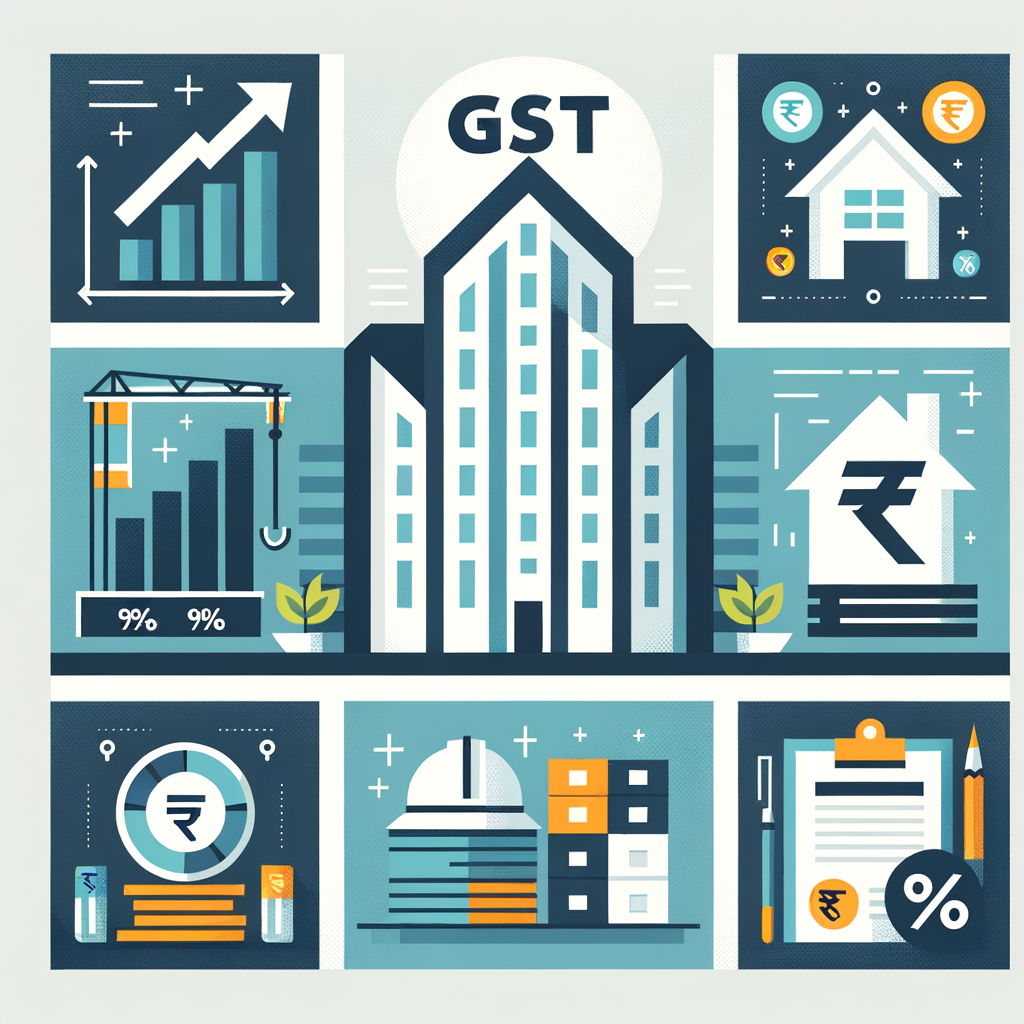GST on Real Estate and Construction – A Guide to the Latest Rate Changes
Buying a property is one of the biggest financial decisions in a person’s life, but the web of taxes involved can often be confusing. A common question we hear is, “What is the final GST I have to pay on my new property?” While the Goods and Services Tax (GST) regime aimed to simplify real estate taxation, the rules are subject to important updates. This guide is designed to demystify the GST rate changes real estate investors, buyers, and builders need to know. Staying informed is crucial—for buyers, it means avoiding overpaying, and for builders, it’s essential for maintaining compliance and avoiding penalties. This article breaks down the latest GST rate changes real estate professionals and buyers must be aware of in the current financial year.
Understanding the Fundamentals: GST on Real Estate in India
Before we dive into the new rates, it’s important to grasp a few basic concepts that form the foundation of understanding GST rates in real estate. The most critical distinction lies in the construction status of the property.
Under-Construction vs. Ready-to-Move-In Properties: The Key GST Distinction
The most fundamental rule is that GST is only levied on the sale of under-construction properties, which includes residential apartments, commercial properties, and bungalows. If you purchase a property that is still being built, GST will be applicable on the transaction value.
Conversely, the sale of ready-to-move-in properties is exempt from GST. A property is considered “ready to move in” if a completion certificate has been issued by the competent authority at the time of sale. This is because the sale of such a property is treated as a transfer of immovable property, which falls outside the ambit of GST.
What is Input Tax Credit (ITC) and Why Was It a Game-Changer?
Input Tax Credit (ITC) was a cornerstone of the initial GST framework for the real estate sector. In simple terms, ITC allowed builders and developers to claim a credit for the GST they paid on their inputs. These inputs include raw materials like cement, steel, bricks, and paint, as well as services like architect fees, labor contracts, and legal consultations. The builder could use this credit to offset their final GST liability on the sale of the property to the home buyer. This mechanism was designed to prevent the “tax on tax” effect, theoretically leading to lower property prices. However, recent changes, which we will now explore, have significantly altered the eligibility for ITC in the residential real estate sector, making it crucial to understand the legal perspectives on ITC on Construction of Immovable Property.
A Deep Dive into the Latest GST Rate Changes for Real Estate
To boost the real estate market and make housing more affordable, the GST Council introduced a major overhaul of the tax structure. The new regime offers significantly lower tax rates for homebuyers but comes with a crucial condition: builders cannot claim Input Tax Credit (ITC) on most residential projects. This has been one of the most significant real estate GST updates India has seen.
New GST Rates for Residential Property Projects
The new rates are primarily categorized based on whether the property qualifies as ‘affordable housing’, creating a distinction for GST On Affordable Housing and Non Affordable Housing.
- Affordable Housing: A property is considered part of an ‘Affordable Housing’ project if it meets specific criteria set by the government, which generally involves a carpet area of up to 60 sq. meters in metropolitan cities and 90 sq. meters in non-metropolitan cities, with a value cap of up to ₹45 lakhs. For such properties, the new effective GST rate is 1% without ITC. This move was specifically designed to make housing more accessible for the lower and middle-income segments.
- Other than Affordable Housing (Non-Affordable): For all other residential properties that do not fall under the affordable housing category, the new effective GST rate is 5% without ITC. This applies to the majority of residential projects in urban and semi-urban areas.
GST Rates for Commercial Properties
The rules for commercial properties are different. GST on commercial units like shops, offices, or co-working spaces continues to be levied at 12% with the benefit of ITC. This applies to standalone commercial projects (Real Estate Commercial Projects – RECP) as well as commercial units sold within a Residential Real Estate Project (RREP), provided the commercial component does not exceed 15% of the total project area. These GST changes for construction projects aim to maintain a clear distinction between residential and commercial taxation.
For better clarity, here is a simple comparison of the old and new GST rates for residential properties:
| Property Type | Old GST Rate (with ITC) | New GST Rate (without ITC) |
|---|---|---|
| Affordable Housing | 8% | 1% |
| Non-Affordable Housing | 12% | 5% |
For official details and circulars, you can always refer to the Central Board of Indirect Taxes and Customs (CBIC) website.
How Do These Construction GST Implications in India Affect You?
These changes have a direct and practical impact on every stakeholder in the real estate transaction. Understanding these implications is key to making informed financial decisions and ensuring compliance.
For Home Buyers: What the New GST Rates Mean for Your Purchase
As a home buyer, the new tax structure brings both advantages and considerations.
- Pros: The most obvious benefit is the lower tax rate displayed on your payment schedule. A rate of 1% or 5% is much simpler and more transparent than the previous effective rates of 8% or 12%. This transparency makes it easier to calculate the final cost of the property without complex adjustments for ITC.
- Cons: Since the builder can no longer claim ITC on construction costs, the tax they pay on materials like steel and cement becomes part of their overall project cost. To maintain their profit margins, some builders may increase the base price of the property to account for this embedded tax.
- Actionable Tip: Always scrutinize your sale agreement and payment receipts. Ensure the builder is applying the correct GST rate (1% or 5%) and that the base price is clearly mentioned. Do not hesitate to ask for a detailed cost breakdown.
For Builders & Developers: Navigating GST Compliance in India
For developers, the new regime simplifies the tax rate but introduces new compliance challenges. Proper GST compliance for builders in India is now more critical than ever.
- The No-ITC Rule: For all new residential projects launched after April 1, 2019, the new rates of 1% and 5% without ITC are mandatory. This means meticulous cost accounting is required, as the GST paid on inputs is now a direct cost to the project.
- Reverse Charge Mechanism (RCM): This is a critical compliance requirement. Under the new rules, a builder or developer must procure at least 80% of their total inputs and input services from GST-registered suppliers. If there is a shortfall in this 80% threshold, the developer must pay GST on the difference under the Reverse Charge Mechanism (RCM). For example, if a builder procures only 70% of materials from registered vendors, they must pay RCM on the 10% shortfall.
- Actionable Tip: Maintaining a detailed and accurate record of all purchases is non-negotiable. Implement a robust vendor management system to ensure you are primarily dealing with GST-registered suppliers. This will help you meet the 80% threshold and avoid unexpected RCM liabilities.
Staying Ahead with Real Estate Tax Compliance Updates
The dynamic nature of GST law means that staying updated is key to avoiding costly errors. Both builders and buyers must be aware of common pitfalls and know where to turn for help.
Common Pitfalls to Avoid
- Incorrect Classification: Mistakenly classifying a non-affordable project as ‘affordable’ to apply the 1% rate can lead to significant penalties.
- RCM Calculation Errors: Failing to accurately track the 80% procurement threshold can result in incorrect RCM calculations and subsequent notices from the tax department.
- Improper Invoicing: Not clearly mentioning the GST rate and amount on customer invoices can create disputes and compliance issues.
How TaxRobo Simplifies GST Compliance
Navigating the complexities of real estate GST can be daunting. At TaxRobo, we specialize in simplifying tax matters for businesses and individuals. From initial GST Registration to day-to-day compliance, our experts are here to help. We ensure accurate calculations, timely filings, and strategic advice on complex issues like RCM and project classification. Let our experts handle your GST filing and compliance so you can focus on building your business. Keeping track of real estate tax compliance updates is our job, so it doesn’t have to be yours.
Conclusion
The latest GST rate changes real estate has undergone have streamlined the tax structure for home buyers, making it more transparent with lower headline rates of 1% for affordable housing and 5% for other residential properties. However, the removal of Input Tax Credit and the introduction of strict procurement rules for builders have added new layers of complexity to compliance. Understanding these nuances is non-negotiable for the financial health of a construction business and for ensuring a fair deal for property buyers.
Confused about the GST impact on your property purchase or construction project? Don’t leave it to chance. Contact the experts at TaxRobo today for clear, accurate, and professional guidance!
Frequently Asked Questions (FAQs)
Q1: Is GST applicable on the sale of land?
A: No, the sale of land by itself is not subject to GST. It is considered a transfer of an immovable asset. However, GST may be applicable on services related to plotted development, such as laying roads, drainage, and other infrastructure.
Q2: I booked my flat before the new GST rates were introduced. Which rate applies to me?
A: For projects that were ongoing when the new rates were implemented, builders were given a one-time option to either continue with the old rates (e.g., 12% with ITC) or switch to the new rates (e.g., 5% without ITC). You must check with your builder to confirm which tax structure they opted for your specific project.
Q3: Can a home buyer claim the GST paid on an under-construction property?
A: No, an end-user who is buying a property for personal use cannot claim Input Tax Credit on the GST paid. ITC is a mechanism available only for businesses to set off taxes paid on inputs against taxes collected on outputs.
Q4: Do I have to pay GST on registration charges and stamp duty?
A: No, stamp duty and registration charges are separate levies imposed by state governments on property transactions. They do not fall under the purview of GST and are paid separately to the respective state’s revenue department. Buyers should also be aware of other applicable taxes, such as Section 194IA: TDS on Purchase of Immovable Property.
Q5: How do these latest GST rate changes real estate rules affect joint development agreements (JDAs)?
A: GST on Joint Development Agreements (JDAs) is a particularly complex area. There are specific rules regarding the timing of tax liability for both the landowner and the developer, as well as the valuation of the services exchanged. Due to the high stakes and complexity, it is highly recommended to seek professional advice from a tax expert for any transactions involving JDAs.



